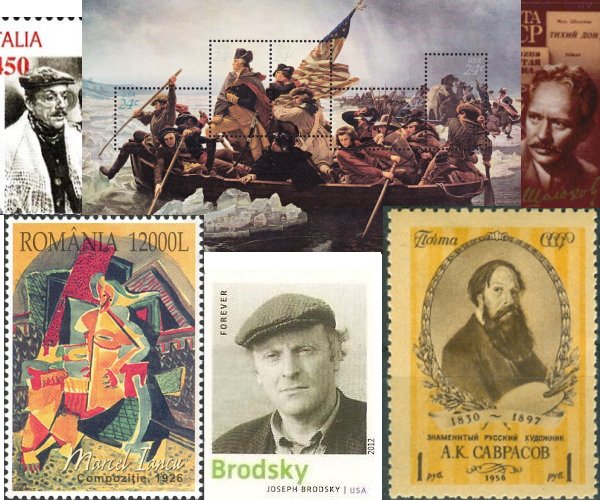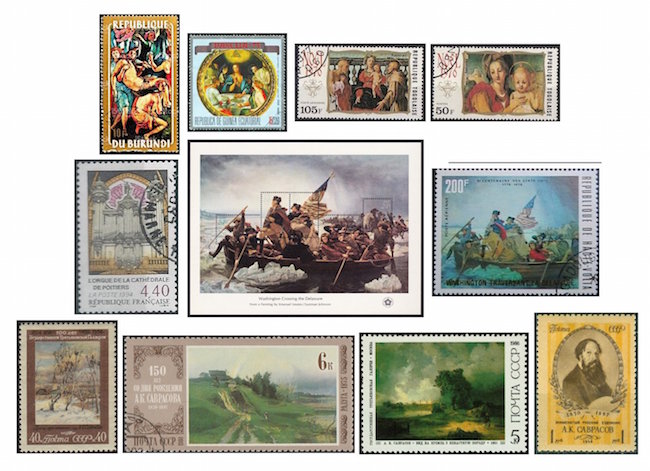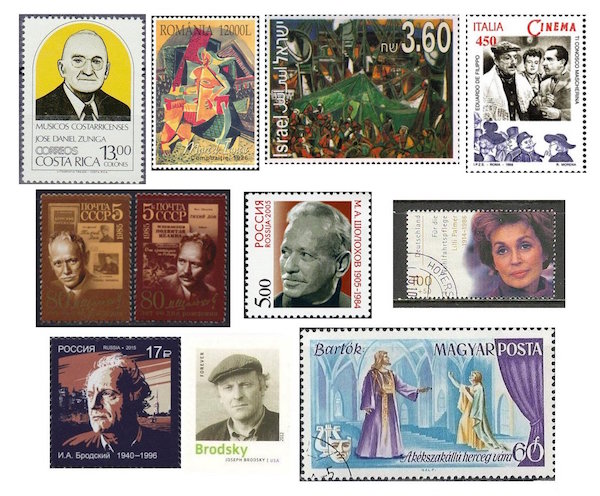The Arts on the Stamps of the World — May 24
An Arts Fuse regular feature: the arts on stamps of the world.

By Doug Briscoe
Two Nobel Prize winners are on the program today, Mikhail Sholokhov and Joseph Brodsky, along with the man who painted Washington Crossing the Delaware.
But we begin with Italian Mannerist painter Jacopo Carucci (May 24, 1494 – January 2, 1557), who came to be known as Jacopo da Pontormo. He served an apprenticeship with Leonardo da Vinci before moving on to other masters and becoming a protégé of the Medici. Active mostly in Florence, Pontormo produced a Deposition from the Cross (1526-8), reproduced on a stamp from Burundi, as one of the decorations for Brunelleschi’s Capponi Chapel. Also in Florence, at the Uffizi, is Pontormo’s Supper At Emmaus (1525), captured on a stamp from Equatorial Guinea. On Christmas stamps from Togo are shown Madonna with Child and Saints Francis and Jerome (c1522), also at the Uffizi, and Madonna and Child with the Infant St John the Baptist (c1514). Another Madonna with Saints, nicknamed the Pala Pucci (1516), is most unusual in that it depicts the Christ Child being held, not by Mary, but in the lap of Saint Joseph.
The exact birthdate of François-Henri Clicquot (b. 1732) is unknown, but he died on this date in 1790. Scion of a family of French organ builders, he restored the 17th-century Parisian organs of Saint-Laurent (1767) and Saint-Nicholas-des-Champs (1777) and built the new instruments of Saint-Sulpice (1776-81) and Souvigny Church (1782). He began work on the organ of the Cathedral of Poitiers in 1787, but did not live to complete it, that office falling to his son Claude François. In 1994, France issued a stamp commemorating this beautiful instrument.
One of our most iconic American images is Washington Crossing the Delaware (1851) by Emanuel Gottlieb Leutze (May 24, 1816 – July 18, 1868). Born in Württemberg, he was brought in childhood to Virginia, then Philadelphia. His father died in 1831, and Leutze, not yet 15, began painting portraits to earn a living. He briefly returned to Germany for study at the Düsseldorf Art Academy under Friedrich Wilhelm von Schadow, son of the sculptor Johann Gottfried Schadow, whose stamps we saw here just last week. The motivation for his most famous painting seems to have been the spirit of the 1848 revolutions in Europe. The first version of Washington Crossing the Delaware was destroyed by an Allied bombing of Bremen in 1942, but Leutze had made a second, larger copy for a French dealer in New York. That’s the version seen today in the Metropolitan Museum of Art. It was reproduced on a large souvenir sheet (here reduced in scale) for the bicentennial as well as on a congratulatory stamp from Burkino Faso (Upper Volta). Another historical Leutze painting is Westward the Course of Empire Takes Its Way (1860), called simply Westward Ho!, executed for a stairway in the U.S. Capitol Building, where it can still be seen. Leutze also painted a portrait of Nathaniel Hawthorne in 1862.
Another 19th-century European painter born on this day was Alexei Savrasov (May 24, 1830 – October 8, 1897), and like Leutze he started drawing at an early age, entering the Moscow School of Painting, Sculpture and Architecture when he was only eight. Nearly twenty years later, he himself became a teacher there. One of his most admired pictures is The Rooks Have Arrived (1871), a harbinger of spring that ushered in the “lyrical landscape” or “mood landscape” style. The other stamps show his Rainbow (1873), View of the Kremlin from the Krymsky Bridge in Inclement Weather (1851), and an 1878 portrait of him by Vasily Perov.
Just the day before yesterday we acknowledged the birthday of Costa Rican composer Julio Fonseca, and May 24 is the birthday of his countryman and colleague José Daniel Zúñiga (24 May 1889 – 23 November 1981). He received his first violin when he was just five years old. He studied and taught in Costa Rica and was selected to join Fonseca and Roberto Cantillano to research the folk music of the Guanacaste region. Some 326 compositions are attributed to him, most of these being children’s songs for schools. There are also hymns, some dance music, and 14 lullabies he wrote for each of his grandchildren.

Romanian-born Marcel Janco (Marcel Hermann Iancu; 1895 – April 21, 1984) grew up in very comfortable circumstances, with a cultivated upbringing and much travel. His first published drawing was of his friend the distinguished pianist Clara Haskil. Janco and two brothers relocated to Switzerland during World War I. There he was one of the co-founders of Dadaism, though soon he split away from the movement. After a spell in France, he returned with his new wife to Romania, where he also worked as an architect. Alarmed by intensifying antisemitism, Janco nevertheless remained in Romania until early 1941, when he and his second wife emigrated to Tel Aviv. Among his activities in his new homeland was the creation of an artists’ colony at the village of Ein Hod. The Romanian stamp shows his 1926 Composition, while the 1993 Israeli stamp reproduces Immigrant Ship of 1945.
The multitalented Eduardo De Filippo (24 May 1900 – 31 October 1984) first trod the boards when he was just four and wrote his first play at 21. He formed a theater company with his siblings in 1932 that drew the attention of Luigi Pirandello, two of whose plays were put on by the group in Neapolitan versions. De Fillipo and Pirandello subsequently wrote a comedy together, L’abito nuovo (1935), based on Pirandello’s earlier novella. De Filippo had already begun appearing in films, beginning with 1933’s Three Lucky Fools (Tre uomini in frack) with Tito Schipa! His directorial debut was with In the Country Fell a Star (In campagna è caduta una stella, 1939), in which he also starred. His best known films are Napoli milionaria (shown in English as Side Street Story, 1950) and Filumena Marturano (1950, based on his own 1946 play). The stamp shows a scene from his 1943 film Ti conosco, mascherina! (I Know You, Little Mask!)—De Fillipo is seen at left.
Mikhail Sholokhov (May 24 [O.S. May 11] 1905 – February 21, 1984) won the Nobel Prize in Literature in 1965, mainly for his novel And Quiet Flows the Don, which occupied him from 1926 to 1940. Accusations of plagiarism arose on the appearance of the first volume of the work in a Soviet magazine in 1928 and resurfaced decades later, with Aleksandr Solzhenitsyn leading the charge. Similarities in style between the novel and Sholokhov’s earlier short story collection Tales from the Don and newer evidence that surfaced in the 1980s and 90s seem to confim Sholokhov’s authorship, but critics remain divided, with some alleging that Sholokhov simply copied out large sections of a work by Fyodor Kryukov (1870-1920), others attributing the original to Venyamin Krasnushkin (1891-1920). (I put my money on Edward de Vere.) A three-part film version directed by Sergei Gerasimov was released in 1958. Sholokhov gets a pair of Soviet stamps from 1985 and a Russian one from 2005.
The mother of German-Jewish actress Lilli Palmer (née Lilli Marie Peiser; 24 May 1914 – 27 January 1986) was also a stage actress, her father a surgeon. The family moved from Poznań (Posen) to Berlin when Lilli was four and to Paris when Hitler came to power. She worked in cabarets until offered a contract by the British Gaumont Film Company. For ten years (1935-45) she made a number of British films before leaving for Hollywood with her husband Rex Harrison in 1945. After another decade she returned to Germany for a busy schedule in films and television. (She and Harrison, who appeared together in The Four Poster in 1952, for which she won a Volpi Cup, were divorced in 1956 or 1957.) Palmer wrote a memoir in 1975 and an autobiographical novel in 1978.

Russian-born American poet Joseph Brodsky won the Nobel Prize in 1987 and was named United States Poet Laureate in 1991. Born Iosif Aleksandrovich Brodsky in St. Petersburg on 24 May 1940, he lived through the Nazi siege of the city, though an aunt of his died of starvation. Marginalized in Soviet society by its antisemitism, he worked odd jobs and taught himself Polish and English in order to translate Czesław Miłosz and John Donne. He began writing his own poems at fifteen and was fortunate enough to meet Anna Akhmatova, who encouraged his work, in 1960. In the decade that followed Brodsky was persecuted as “anti-Soviet’ and a “parasite”, placed in a mental hospital, and condemned to Siberian exile for eighteen months, a period that was not entirely unpleasant for him. Protests from such figures as Akhmatova, Evtushenko, Shostakovich, and Sartre brought about his release, but harassment continued until he was actually forced to leave the country in 1972. He came to the United States, where he taught at a number of schools including Mount Holyoke College. He was only 55 when he died of heart failure on January 28th, 1996.
I mentioned yesterday that Beethoven prepared three versions of his only opera. Coincidentally, the same is true of Béla Bartók. Bluebeard’s Castle, composed in 1911, was revised the following year and given a new ending in 1917. It had its first performance in Budapest on 24 May 1918, so today is the 99th anniversary. The Hungarian stamp informs us that the title in the original is A kékszakállú herceg vára (a CAKE-sa-kah-lu HAIRT-sek VAH-ra; literally: The Blue-Bearded Duke’s Castle).
Two fine novelists get an honorable mention today: the late Irish writer William Trevor (24 May 1928 – 20 November 2016) and the American Pulitzer Prize winner Michael Chabon (born May 24, 1963).
I notice, too, that May 24th is the birthday of three very fine English actors, Jim Broadbent (1949), Alfred Molina (1953), and Kristen Scott Thomas (1960).
A graduate of the University of Massachusetts with a B.A. in English, Doug Briscoe worked in Boston classical music radio, at WCRB, WGBH, and WBUR, for about 25 years, beginning in 1977. He has the curious distinction of having succeeded Robert J. Lurtsema twice, first as host of WGBH’s weekday morning classical music program in 1993, then as host of the weekend program when Robert J.’s health failed in 2000. Doug also wrote liner notes for several of the late Gunther Schuller’s GM Recordings releases as well as program notes for the Boston Classical Orchestra. For the past few years he’s been posting a Facebook “blog” of classical music on stamps of the world, which has now been expanded to encompass all the arts for The Arts Fuse.
